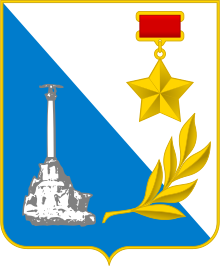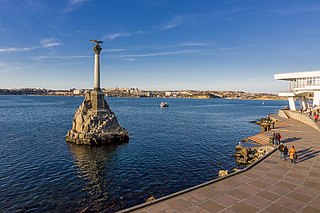
Sevastopol, sometimes written Sebastopol, is the largest city in Crimea and a major port on the Black Sea. Due to its strategic location and the navigability of the city's harbours, Sevastopol has been an important port and naval base throughout its history. Since the city's founding in 1783 it has been a major base for Russia's Black Sea Fleet, and it was previously a closed city during the Cold War. The total administrative area is 864 square kilometres (334 sq mi) and includes a significant amount of rural land. The urban population, largely concentrated around Sevastopol Bay, is 479,394, and the total population is 547,820.

Russia is divided into several types and levels of subdivisions.
Balaklava is a settlement on the Crimean Peninsula and part of the city of Sevastopol. It is an administrative center of Balaklava Raion that used to be part of the Crimean Oblast before it was transferred to Sevastopol Municipality. Population: 18,649 .

Krasnoperekopsk is a town in Crimea. Following the 2014 annexation of Crimea, it was incorporated into Russia's Republic of Crimea, though the territory is recognised by a majority of countries as part of Ukraine within the Autonomous Republic of Crimea. It is the administrative center of Krasnoperekopsk Raion. Administratively is not a part of the raion (district) and incorporated separately as a town of regional significance. Population: 26,268 .

Gagarinsky District is the name of several administrative and municipal districts in Russia.
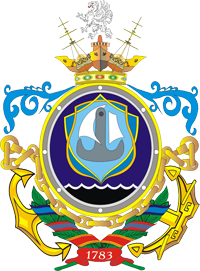
Sevastopol Shipyard is a shipyard located in Sevastopol, Crimea, founded as a dockyard for the Imperial Russian Navy in 1783.

The State Emblem of the Soviet Union was adopted in 1923 and was used until the dissolution of the Soviet Union in 1991. Although it technically is an emblem rather than a coat of arms, since it does not follow traditional heraldic rules, in Russian it is called герб, the word used for a traditional coat of arms.

The Declaration of Independence of the Autonomous Republic of Crimea and Sevastopol was a joint resolution adopted on March 11, 2014 by the Supreme Council of Crimea and the Sevastopol City Council that proclaimed the Autonomous Republic of Crimea and the city of Sevastopol a sovereign state — the Republic of Crimea. The decision was taken after unmarked Russian soldiers invaded Ukraine and seized the Crimean parliament.
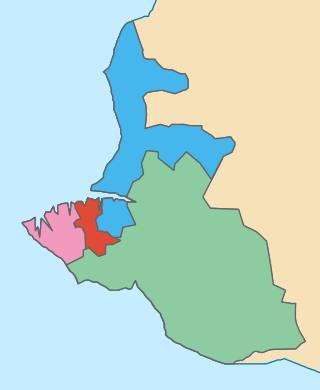
Sevastopol is a city on the Black Sea, located in the southwest of the Crimean Peninsula—a territory disputed between Russia and Ukraine as a result of the 2014 Crimean crisis. It has been under the de facto Russian control since March 2014, when it was incorporated into Russia as one of its federal subjects, with a status of a federal city. Being a disputed territory, Sevastopol has two sets of laws governing how its administrative and municipal divisions are set up. Under both Ukrainian and Russian laws, the city is administratively divided into four districts.

The coat of arms of Astana, the capital of Kazakhstan, was originally adopted on 5 June 2008, with it being readopted on 13 September 2022 after the city changed its name after the President of Kazakhstan Kassym-Jomart Tokayev signed a constitutional amendment to revert to the name Astana.

The coat of arms of the Bryansk Oblast was approved by the Bryansk Oblast Duma on November 5, 1998. According to the official description provided by the legislature of the oblast, the arms of the Bryansk Oblast "reflect the characteristic features of the area and its inhabitants: industry and patriotism.

The coat of arms of the Omsk Oblast in Russia were adopted 29 April 2020 by Governor Alexander Burkov.

The Legislative Assembly of Sevastopol is the regional parliament of Sevastopol. It de facto replaced the Sevastopol City Council after the Russian military intervention in Crimea in 2014. The legislature is composed of 24 members.

Governor Election in Sevastopol were held on 10 September 2017. It was the second election of the Governor of Sevastopol after the 2014 Russian annexation of Crimea, and was the first direct elections for Governor.

The Monument to the Sunken Ships is the symbol of the city of Sevastopol, on the disputed Crimean peninsula. Located in Sevastopol Bay, it was designed by Amandus Adamson and built by Valentin Feldmann in 1905.

Mikhail Vladimirovich Razvozhayev is a Russian statesman and politician. He is currently the internationally unrecognized Governor of Sevastopol since 2 October 2020. He served as the Secretary of the Sevastopol Regional Branch of the United Russia Party since October 25, 2019. Razvozhayev had served as the acting Head of the Republic of Khakassia from October 3 to November 15, 2018. He also worked as the Deputy Minister of the Russian Federation for North Caucasus Affairs from October 1, 2014 to October 3, 2018. He also served as the head of the Executive Committee of the All-Russian Popular Front, member of the Central Head of ONF from December 17, 2018 to July 11, 2019.
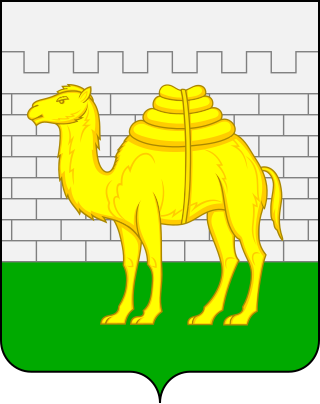
The coat of arms of Chelyabinsk is the official municipal coat of arms of Chelyabinsk, Russia. The current design, adopted on 12 September 2000 by the City Duma, features a gold camel loaded with goods on its back. The shield is divided into two fields, with the top being taller than the first. The top field is silver and is designed to resemble a brick wall. The bottom field is green.

Olga Leonidovna Timofeyeva, is a Russian politician who is currently the Deputy Governor of Sevastopol since 8 October 2019.

The flag of the Kherson Oblast is the official symbol of the Kherson Oblast of Ukraine, along with the coat of arms. Approved by the decision of the Kherson Regional Council No. 440 of 25 October 2001.
Legendary Sevastopol is the official anthem of the hero city of Sevastopol. Approved by the decision of the I session of the City Council of the XXII convocation dated July 29, 1994. It was composed by Vano Muradeli, with lyrics created by Pyotr Gradov.
